You are using an out of date browser. It may not display this or other websites correctly.
You should upgrade or use an alternative browser.
You should upgrade or use an alternative browser.
Export thread
Victa Mowers (It's Summer Down Under!)
#1

Two-Stroke
Two-Stroke
Since there's no forum for the brand I thought I'd start a thread about a great Australian mower: Victa. They continue to make two-cycle mowers -- which is interesting to me as a two-stroke hobbyist. 
Unsurprisingly, their older models are the most interesting. Here's a 1968 model. I like the idea of getting the air intake away from ground level.
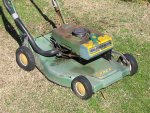
Here's a Victa ad (obviously old -- notice the footware :confused2: ):
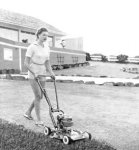
Another one that looks like 1950s vintage:
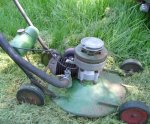
For more about the brand check out the Wikipedia page.
Unsurprisingly, their older models are the most interesting. Here's a 1968 model. I like the idea of getting the air intake away from ground level.

Here's a Victa ad (obviously old -- notice the footware :confused2: ):

Another one that looks like 1950s vintage:

For more about the brand check out the Wikipedia page.
#3

reynoldston
reynoldston
Sounds like you are getting into the grass cutting and we are into snow removal. Just had to fix the engine cut out switch in the throttle of my ATV so I can plow snow. Looks like a nice hobby Victa mowers. The picture of the small 2 cycle looks like it has its job cut out for it seeing the length of the grass its cutting.
#4

Two-Stroke
It's not me... I'm in Georgia so I'm not mowing too much right now. :laughing:
I first heard about Victa from another member on LMF a couple years ago and a recent thread on powder coating in the Lawn-Boy forum got my interest up again. An Australian member who has a bunch of them may post some photos and comments -- if we're lucky.
Two-Stroke
Sounds like you are getting into the grass cutting and we are into snow removal. Just had to fix the engine cut out switch in the throttle of my ATV so I can plow snow. Looks like a nice hobby Victa mowers. The picture of the small 2 cycle looks like it has its job cut out for it seeing the length of the grass its cutting.
It's not me... I'm in Georgia so I'm not mowing too much right now. :laughing:
I first heard about Victa from another member on LMF a couple years ago and a recent thread on powder coating in the Lawn-Boy forum got my interest up again. An Australian member who has a bunch of them may post some photos and comments -- if we're lucky.
#5

Lawnboy18
Lawnboy18
That lady mowing tho.
I've heard about them. Love the breather tube on the carb along the handle.
I've heard about them. Love the breather tube on the carb along the handle.
#6
B
bertsmobile1
AFAIK Victa was the only mower company that originated by some one trying to make life easier for the person doing the mowing.
A philosophy that has guided the company till 2008 when Briggs took them over.
In this case it was the founder ( Merv ) who was looking for an easier way for his son to pay his way through Uni by mowing lawns.
He is credited with the invention of the walk behind powered rotary mower and he never took out a patient
Every one who saw it being used wanted one & the rest is history.
Because it is dry & dusty around Sydney in the summer, Merv moved the filter away from the engine where it regularly blocked up in 1952.
Honda started doing this in 2013 , Briggs still have them on the engine, says somthing about the motives of the companies doesn't it ?
Because the typical Aussie yard has shrubs surrounding a lawn playing area Merv added a trip handle so it could easily mow under low bushes and that was about 1955.
The original Green painted mowers had no skirts on the base so we bunch them all together under the nic name "Toe Cutters" for the obvious reason, particularly as we had a rather bad habit of mowing bare foot or in thongs.
And yes I mowed bare foot in my teens. fifty years on I wear steel caps with mowers that are 1000% safer than anything I could buy back in the 60's .
Merv went for 2 strokes because all of the side banger 4 strokes of the early 50's weighed a ton with massive flywheels where as most 2 strokes were around 1/2 the weight even with full cast iron engines and alloy heads.
And remember he was trying to make our life easier, not himself richer.
The modern , soon the be discontinued Power Torque is still a one piece iron engine with alloy head and is still lighter than any 4 stroke of equivalent power.
It requires almost no maintenance, is not affected by rain, ethanol or heavy dust. Has no external cables to get snagged ( it runs inside the snorkel ) and if the 5 "O" rings are replaced every 10 years will happily run for 50 years if the trigger module embedded in the coil hangs in ( another Aussie invention ). I usually retro fit the plain coil & trigger when they pack it in, and by coil, I mean coil, just the coil itself which slips over the lamination core, easy.
The starter rope which is in a fitting that becomes the crank case can be replaced in situ by removing 3 screws that hold the top cover on, all of about 6 minutes ( 3 if I am in a hurry).
Below is an old POS poster with a cut drawing of the mk II Power torque and yes, the fly wheel & ignition coil are under the engine.
Decompressor is a normally open diaphram which is closed by a vacuum signal from the carb.
Govening is also done with a diaphram powered by a venturi vacuum signal again, this time from the fly wheel, acting against a spring inside the carb. These are available in 8 strengths to vary the running speed and are changed via a pop off cap on the side of the carb, again a 2 minute job ( if that ).
the carb is all plastic and control is via a poppet valve so there is no butterfly shaft to leak & make the engine run lean and no screws to get sucked into the engine,
On the other side the muffler is held on by two springs ( no bolts ) and takes about 1.5 to 2 minutes to remove to check the bore or relace the muffler which discharges down under the deck.

B
bertsmobile1
That lady mowing tho.
I've heard about them. Love the breather tube on the carb along the handle.
AFAIK Victa was the only mower company that originated by some one trying to make life easier for the person doing the mowing.
A philosophy that has guided the company till 2008 when Briggs took them over.
In this case it was the founder ( Merv ) who was looking for an easier way for his son to pay his way through Uni by mowing lawns.
He is credited with the invention of the walk behind powered rotary mower and he never took out a patient
Every one who saw it being used wanted one & the rest is history.
Because it is dry & dusty around Sydney in the summer, Merv moved the filter away from the engine where it regularly blocked up in 1952.
Honda started doing this in 2013 , Briggs still have them on the engine, says somthing about the motives of the companies doesn't it ?
Because the typical Aussie yard has shrubs surrounding a lawn playing area Merv added a trip handle so it could easily mow under low bushes and that was about 1955.
The original Green painted mowers had no skirts on the base so we bunch them all together under the nic name "Toe Cutters" for the obvious reason, particularly as we had a rather bad habit of mowing bare foot or in thongs.
And yes I mowed bare foot in my teens. fifty years on I wear steel caps with mowers that are 1000% safer than anything I could buy back in the 60's .
Merv went for 2 strokes because all of the side banger 4 strokes of the early 50's weighed a ton with massive flywheels where as most 2 strokes were around 1/2 the weight even with full cast iron engines and alloy heads.
And remember he was trying to make our life easier, not himself richer.
The modern , soon the be discontinued Power Torque is still a one piece iron engine with alloy head and is still lighter than any 4 stroke of equivalent power.
It requires almost no maintenance, is not affected by rain, ethanol or heavy dust. Has no external cables to get snagged ( it runs inside the snorkel ) and if the 5 "O" rings are replaced every 10 years will happily run for 50 years if the trigger module embedded in the coil hangs in ( another Aussie invention ). I usually retro fit the plain coil & trigger when they pack it in, and by coil, I mean coil, just the coil itself which slips over the lamination core, easy.
The starter rope which is in a fitting that becomes the crank case can be replaced in situ by removing 3 screws that hold the top cover on, all of about 6 minutes ( 3 if I am in a hurry).
Below is an old POS poster with a cut drawing of the mk II Power torque and yes, the fly wheel & ignition coil are under the engine.
Decompressor is a normally open diaphram which is closed by a vacuum signal from the carb.
Govening is also done with a diaphram powered by a venturi vacuum signal again, this time from the fly wheel, acting against a spring inside the carb. These are available in 8 strengths to vary the running speed and are changed via a pop off cap on the side of the carb, again a 2 minute job ( if that ).
the carb is all plastic and control is via a poppet valve so there is no butterfly shaft to leak & make the engine run lean and no screws to get sucked into the engine,
On the other side the muffler is held on by two springs ( no bolts ) and takes about 1.5 to 2 minutes to remove to check the bore or relace the muffler which discharges down under the deck.

#7
B
bertsmobile1
B
bertsmobile1
To give you a good idea just how user friendly these Victa mowers are.
Here is a link to some high school students who made youtube videos of them selves repairing ( mutilating IMHO ) Victa's at a local tip ( dump to some ).
You really can repair , well get them to run any way, with little more than a hammer & chisel ( fitters tool box )
From that they started a retail parts and repair business on evilbay.
https://www.youtube.com/user/Lachymx
All the base plates are common regardless of the engine used so note just how much lower the 2 strokes are comparred to the ones with 4 strokes.
If I get a minute tomorrow I will wander around the shop with the digital and post some pickies.
Here is a link to some high school students who made youtube videos of them selves repairing ( mutilating IMHO ) Victa's at a local tip ( dump to some ).
You really can repair , well get them to run any way, with little more than a hammer & chisel ( fitters tool box )
From that they started a retail parts and repair business on evilbay.
https://www.youtube.com/user/Lachymx
All the base plates are common regardless of the engine used so note just how much lower the 2 strokes are comparred to the ones with 4 strokes.
If I get a minute tomorrow I will wander around the shop with the digital and post some pickies.
#8

Lawnboy18
Lawnboy18
Thanks for all that info! I love old mowers! Especially the ones that were unique in their design. You seem to have worked a lot on Victa mowers!
Please do get some pictures!
Please do get some pictures!
#9

2smoked
2smoked
Hey bertsmobile,
Thank you for the history lesson and the description of the Victa engine. Those old "toe cutter" models are works of art in my opinion. And thank you in advance for any pictures you post.
And thank you two stroke for starting this thread. I will certainly check back often.
Thank you for the history lesson and the description of the Victa engine. Those old "toe cutter" models are works of art in my opinion. And thank you in advance for any pictures you post.
And thank you two stroke for starting this thread. I will certainly check back often.
#10

Two-Stroke
Two-Stroke
I found some pictures of a beautifully restored Victa "Toe Cutter".
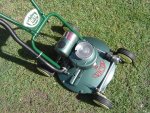
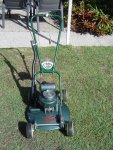
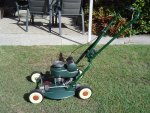
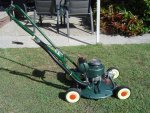
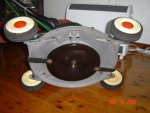
A few things are worth noting:
It has shaft-driven 4WD -- but plain old wrap-the-rope starting. :confused3:
The engine exhaust is directed under the deck -- Did Victa do this first or Lawn-Boy... or someone else?
Instead of a fixed blade it has a disk fitted with spinning blades. Jacobsen had this design in the 1960s -- others too, I think. This, combined with completely open deck sides, means that the mower would be almost impossible to clog.
Trial Lawyers Wet Dream: In addition to chopping off toes, the lack of sides on the deck would mean that debris like small rocks would fly out in all directions. :shocked:





A few things are worth noting:
It has shaft-driven 4WD -- but plain old wrap-the-rope starting. :confused3:
The engine exhaust is directed under the deck -- Did Victa do this first or Lawn-Boy... or someone else?
Instead of a fixed blade it has a disk fitted with spinning blades. Jacobsen had this design in the 1960s -- others too, I think. This, combined with completely open deck sides, means that the mower would be almost impossible to clog.
Trial Lawyers Wet Dream: In addition to chopping off toes, the lack of sides on the deck would mean that debris like small rocks would fly out in all directions. :shocked:
#11

Two-Stroke
Two-Stroke
Here's a video of a 1956 model Victa 18 Rotomo:
The sound of those early two-strokes... :cloud9:
The sound of those early two-strokes... :cloud9:
#12

Lawnboy18
Lawnboy18
That is a very unique and nice mower! Love the sound. You can't get a mower more simple than that!
#13
B
bertsmobile1
If the colour is correct then it is more unique than you could imagine.
AFAIK all Victas were green till the mid 60's with the exception of badge engineered storebrand mowers
There is a nice collection of early Victas on this video, none were started but all look correct.
Note both the Auo & Special ( last two in line up ) have alloy bases.
They made both alloy & steel bases concurrently and still do
Nothing I have is any where as old as those, I go back to around 1970.
There might be some slightly older ones in the grave yard ( old mowers for spares ) but it is a big pile to sort through.
B
bertsmobile1
That is a very unique and nice mower! Love the sound. You can't get a mower more simple than that!
If the colour is correct then it is more unique than you could imagine.
AFAIK all Victas were green till the mid 60's with the exception of badge engineered storebrand mowers
There is a nice collection of early Victas on this video, none were started but all look correct.
Note both the Auo & Special ( last two in line up ) have alloy bases.
They made both alloy & steel bases concurrently and still do
Nothing I have is any where as old as those, I go back to around 1970.
There might be some slightly older ones in the grave yard ( old mowers for spares ) but it is a big pile to sort through.
#14
B
bertsmobile1

B
bertsmobile1
ok .
had a wander around, camera in hand.
Will do these in batches to keep posts to a reasonable size.
Starting with the commercials.
These are 2 Victa Slashers ( 3 including the one in the shop with broken spring )
The orange ones are 1969 and 1971, the red one is 1988.
All are in regular use, I have sold 4 of them in the last 18 months as in small yards ( 0.5 acres or less ) they are quicker than a ride on / push mow / trimmer combo.
Usually I "lend " one out to customers whose mowers will be a week or more in the shop.
Every one is defiant that they will not even think of using it, about 1/3 ask if they can buy one.
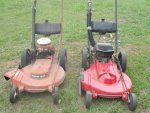
The Orange on is a Super 24 because it is a 24" cut, The red one is a 600 because the metric ****s objected to using inch names in a metric country.
They have 2 flat or fluted swing back blades on a large diameter round blade plate, the same blades ( 4 ) on a bigger plate go on the 30" & 32" ride ons.
This orange one has an optional double cartridge filter at the base of the snorkel while the red runs a std single filter at the top but has the large diameter snorkel tube ( makes absolutely no difference )
In around 300 hours I have never needed to replace an air filter. They are both heavy mowers and were standard equipment for local councils to mow roadsides, playing fields and the like till the late 80's
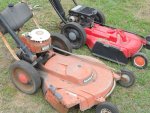
The Orange one has a 160cc VC engine and the red is a Power Torque Mk I
The VC engines with round pull starts are hard to come by as 2 local companies made mini bikes using this engine and you could also buy the frame kit and provide ( borrow) your own motor.
When I was in high school ( 12 yo to 18 yo ) we used to make mini bike frames in metal shop to fit Victa mower engines, they were very popular and probably explain a lot of "vanishing" mowers.
Both have alloy bases the orange ones run at 3500 rpm the red at 3300 rpm, have not noticed any difference in use.
I can cut down saplings to about 2" did with thse units and regularly do along the fence run that is too dangerous to run the ride on with out front slasher due to wombat holes, wash aways & wallaby tracks.
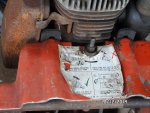
Both are belt drive, the orange ones pull the engine back while the red pushes the motor back as the alloy plates tend to fracture around the tensioning nut.
Two big bearings on the blade plate
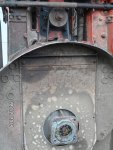
This one is in the shop for a spring replacement and bearing repack
had a wander around, camera in hand.
Will do these in batches to keep posts to a reasonable size.
Starting with the commercials.
These are 2 Victa Slashers ( 3 including the one in the shop with broken spring )
The orange ones are 1969 and 1971, the red one is 1988.
All are in regular use, I have sold 4 of them in the last 18 months as in small yards ( 0.5 acres or less ) they are quicker than a ride on / push mow / trimmer combo.
Usually I "lend " one out to customers whose mowers will be a week or more in the shop.
Every one is defiant that they will not even think of using it, about 1/3 ask if they can buy one.

The Orange on is a Super 24 because it is a 24" cut, The red one is a 600 because the metric ****s objected to using inch names in a metric country.
They have 2 flat or fluted swing back blades on a large diameter round blade plate, the same blades ( 4 ) on a bigger plate go on the 30" & 32" ride ons.
This orange one has an optional double cartridge filter at the base of the snorkel while the red runs a std single filter at the top but has the large diameter snorkel tube ( makes absolutely no difference )
In around 300 hours I have never needed to replace an air filter. They are both heavy mowers and were standard equipment for local councils to mow roadsides, playing fields and the like till the late 80's

The Orange one has a 160cc VC engine and the red is a Power Torque Mk I
The VC engines with round pull starts are hard to come by as 2 local companies made mini bikes using this engine and you could also buy the frame kit and provide ( borrow) your own motor.
When I was in high school ( 12 yo to 18 yo ) we used to make mini bike frames in metal shop to fit Victa mower engines, they were very popular and probably explain a lot of "vanishing" mowers.
Both have alloy bases the orange ones run at 3500 rpm the red at 3300 rpm, have not noticed any difference in use.
I can cut down saplings to about 2" did with thse units and regularly do along the fence run that is too dangerous to run the ride on with out front slasher due to wombat holes, wash aways & wallaby tracks.

Both are belt drive, the orange ones pull the engine back while the red pushes the motor back as the alloy plates tend to fracture around the tensioning nut.
Two big bearings on the blade plate

This one is in the shop for a spring replacement and bearing repack
Attachments
#15
B
bertsmobile1
Not quite,
the shaft going to the boxes front & back is the height adjuster not a drive shaft.
This model had invinately variable height adjustment to around 4 "
Standard for this model was a wire rope recoil start that was no end of trouble, it bolted into the 4 holes on top of the cowl and followed the shape of the slightly raised lip you can see.
This starter is very rare now days and oft brings near $ 1000 as in the period most were tossed away or sold as scrap as they were aluminium.
Victa started the under deck exhaust with the model you are looking at around 1958 / 59.
It was a feature on the deluxe models, fitted with their own engine.
It was a mish mash for a while with most alloy decks having under deck exhausts and most steel decks had pointing foreword exhausts. They made both types concurrently.
When they went to east-west orientation of the engine just about all were under deck except the 4 strokes which is the current practice.
That particular shade of green hammer tone paint wa exclusive to Victa and he has done really well to reproduce it as it is not made any more and hammer finish is really hard to colour match
B
bertsmobile1
I found some pictures of a beautifully restored Victa "Toe Cutter".
A few things are worth noting:
It has shaft-driven 4WD -- but plain old wrap-the-rope starting. :confused3:
The engine exhaust is directed under the deck -- Did Victa do this first or Lawn-Boy... or someone else?
Instead of a fixed blade it has a disk fitted with spinning blades. Jacobsen had this design in the 1960s -- others too, I think. This, combined with completely open deck sides, means that the mower would be almost impossible to clog.
Trial Lawyers Wet Dream: In addition to chopping off toes, the lack of sides on the deck would mean that debris like small rocks would fly out in all directions. :shocked:
Not quite,
the shaft going to the boxes front & back is the height adjuster not a drive shaft.
This model had invinately variable height adjustment to around 4 "
Standard for this model was a wire rope recoil start that was no end of trouble, it bolted into the 4 holes on top of the cowl and followed the shape of the slightly raised lip you can see.
This starter is very rare now days and oft brings near $ 1000 as in the period most were tossed away or sold as scrap as they were aluminium.
Victa started the under deck exhaust with the model you are looking at around 1958 / 59.
It was a feature on the deluxe models, fitted with their own engine.
It was a mish mash for a while with most alloy decks having under deck exhausts and most steel decks had pointing foreword exhausts. They made both types concurrently.
When they went to east-west orientation of the engine just about all were under deck except the 4 strokes which is the current practice.
That particular shade of green hammer tone paint wa exclusive to Victa and he has done really well to reproduce it as it is not made any more and hammer finish is really hard to colour match
#16
B
bertsmobile1
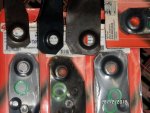
This is why I rabbit on about how "User oriented" Victa was.
Since 1952 Victa have only used 22 different blades and most of them were in the early days till they got it right.
There are 11 blades covering 1974 till now and 2 of them are different thickness of the same blade.
Because Model names mean nothing to workshops ( purely marketing ) and because they made better than 50 different shop branded mowers, Victa code the actual blades.
In the above photo note that the short end of each type of blade has different corner cuts so as long as the customer has that reminant of the blade I can supply the correct blades for their mower.
And you would not believe how many come in with only just that much blade left.
Swing back blades are supposed to be balanced to within 6 gram, but as long as the mower cuts the grass a lot of people are happy to use a mower that is literally leaping from side to side.
Then they get cranky because the deck splits or handle breaks
B
bertsmobile1

This is why I rabbit on about how "User oriented" Victa was.
Since 1952 Victa have only used 22 different blades and most of them were in the early days till they got it right.
There are 11 blades covering 1974 till now and 2 of them are different thickness of the same blade.
Because Model names mean nothing to workshops ( purely marketing ) and because they made better than 50 different shop branded mowers, Victa code the actual blades.
In the above photo note that the short end of each type of blade has different corner cuts so as long as the customer has that reminant of the blade I can supply the correct blades for their mower.
And you would not believe how many come in with only just that much blade left.
Swing back blades are supposed to be balanced to within 6 gram, but as long as the mower cuts the grass a lot of people are happy to use a mower that is literally leaping from side to side.
Then they get cranky because the deck splits or handle breaks
#17
B
bertsmobile1

B
bertsmobile1
Re: Victa Mowers (It's Summer Down Under!) The Quiet Series
One of the big complaints about 2 strokes ( which you won't find on this site ) is the noise.
Victa spent millions researching where the noise is comming from and then doing something about it.
The solution was to make the discharge chute a lot taller & thinner as seen in the last photo.
They then made a full cowl which bolted tight to those holes to enclose the noise.
This is the old VC motor in a Mustang which was Victa's top model at that time.
This one had chrome plated double fold handles , ball bearing wheels and the "magic eye" catcher that clipped onto rear flap to prevent noise loss.
The result was very quiet, for a blue smoke just slightly louder than the current 4 stroke alternative at the time.
the green catcher is wrong, it should have been either white or black. And they have been playing silly buggers with the throttle cable. from about 1976
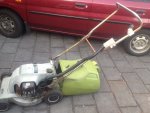
I pinched this of evilbay
This is the Mustang resplendant in green with the correct green catcher still the VC series engine about 1979 with a Utility next door fitted with the Mk I Power Torque.
The Utilitys were always side discharge with no catcher. Note the squat muffler on the Utility and the long muffler on the Mustang.

The Vortex was the next big leap. Victa had finally cracked it by finding out the remaining noise was coming from the blades and air pumping.
The mower was inaudiable from about 30 ft away. The tooled up for a massive production run. It was the top of the line and amazing.
Unfortunately the buracrats who all live in units and would be hard pressed to work out how to take a lawn mower out of its box let alone actually use one decided it was a safety risk so despite very strong demand it was quitely withdrawn from the market & Victa was broke.
All these Vortex were red and have a unique blade plate & blades. They regularly go for $ 1000 + despite being illegal to use or import into half the world ( USA included ).
Victa salvaged what they could with the second generation Vortex , The yellow one in the photo below.
It had a modified std blade plate with a rubber skirt around the outside. While being a lot noisier than the red Vortex it was the quietest mower on the market in its day and is still the quietist push mower money can buy.
However the pencil d..ks were not satisfied and decided it had to be fitted with some "visual running indicator" to be allowed into the USA .( Bet a lot of Senators dinned out on that one for a long while ).
So it got rebadged as the Mustang which had a strong market in The UK & Europe
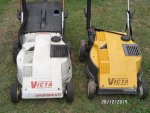
The Yellow Vortx 1984 & white Mustang 1986 mowers above are identical to the cheaper Charger model shown below except for the extra plastic. & skirt around the blade disc.
note the holes in the base near the wheels and in front of the catcher for the big cowl .
Despite the constricted shape this mower will still cut 6" of wet grass and manage to toss it all into the catcher .
This Magic Eye catcher is a little blind, having losts it's eye and was the biggest solid catcher available at the time.
Because it clips to the outside of the discharge chute cover it is a bit fiddly to fit.
Despite being 30 years old I still get $ 200-$ 300 for a good one with serviceable catcher
ATTACH=CONFIG]24553[/ATTACH]
One of the big complaints about 2 strokes ( which you won't find on this site ) is the noise.
Victa spent millions researching where the noise is comming from and then doing something about it.
The solution was to make the discharge chute a lot taller & thinner as seen in the last photo.
They then made a full cowl which bolted tight to those holes to enclose the noise.
This is the old VC motor in a Mustang which was Victa's top model at that time.
This one had chrome plated double fold handles , ball bearing wheels and the "magic eye" catcher that clipped onto rear flap to prevent noise loss.
The result was very quiet, for a blue smoke just slightly louder than the current 4 stroke alternative at the time.
the green catcher is wrong, it should have been either white or black. And they have been playing silly buggers with the throttle cable. from about 1976

I pinched this of evilbay
This is the Mustang resplendant in green with the correct green catcher still the VC series engine about 1979 with a Utility next door fitted with the Mk I Power Torque.
The Utilitys were always side discharge with no catcher. Note the squat muffler on the Utility and the long muffler on the Mustang.

The Vortex was the next big leap. Victa had finally cracked it by finding out the remaining noise was coming from the blades and air pumping.
The mower was inaudiable from about 30 ft away. The tooled up for a massive production run. It was the top of the line and amazing.
Unfortunately the buracrats who all live in units and would be hard pressed to work out how to take a lawn mower out of its box let alone actually use one decided it was a safety risk so despite very strong demand it was quitely withdrawn from the market & Victa was broke.
All these Vortex were red and have a unique blade plate & blades. They regularly go for $ 1000 + despite being illegal to use or import into half the world ( USA included ).
Victa salvaged what they could with the second generation Vortex , The yellow one in the photo below.
It had a modified std blade plate with a rubber skirt around the outside. While being a lot noisier than the red Vortex it was the quietest mower on the market in its day and is still the quietist push mower money can buy.
However the pencil d..ks were not satisfied and decided it had to be fitted with some "visual running indicator" to be allowed into the USA .( Bet a lot of Senators dinned out on that one for a long while ).
So it got rebadged as the Mustang which had a strong market in The UK & Europe

The Yellow Vortx 1984 & white Mustang 1986 mowers above are identical to the cheaper Charger model shown below except for the extra plastic. & skirt around the blade disc.
note the holes in the base near the wheels and in front of the catcher for the big cowl .
Despite the constricted shape this mower will still cut 6" of wet grass and manage to toss it all into the catcher .
This Magic Eye catcher is a little blind, having losts it's eye and was the biggest solid catcher available at the time.
Because it clips to the outside of the discharge chute cover it is a bit fiddly to fit.
Despite being 30 years old I still get $ 200-$ 300 for a good one with serviceable catcher
ATTACH=CONFIG]24553[/ATTACH]
Attachments
#18
B
bertsmobile1
I forgot to reply to the last 2 items.
The first Billy cart / peach tin Victa has fixed blades ( 1952) on a blade bar. From 1954 onwards all Victas were fitted with swing back blades fitted to a deeply dished disk and this included the ride ons that were imported from the USA and the ones they tried to make locally.
As for flying rocks you are correct.
They did make an optional skirt for the sides and rubber flaps for front or back or both but seldom were they fitted. Remember in 1960 a rotary mower cost around 2 months wages, before you started adding extras. Most were bought on hire contract so by the time they were finally paid off over the typical 4 years the cost was closer to 6 months wages. My own father rode a push bike 10 miles to & from work so he could afford to pay for his first petrol mower. Then it was a fridge followed by a TV so if there was no overtime we went hungry.
As for lawers, we did not get free university education till the Whitlam government (1974) so the few lawers available were totally run off their feet doing divorces
B
bertsmobile1
I found some pictures of a beautifully restored Victa "Toe Cutter".
View attachment 24540
View attachment 24541
View attachment 24543
View attachment 24544
View attachment 24542
A few things are worth noting:
It has shaft-driven 4WD -- but plain old wrap-the-rope starting. :confused3:
The engine exhaust is directed under the deck -- Did Victa do this first or Lawn-Boy... or someone else?
Instead of a fixed blade it has a disk fitted with spinning blades. Jacobsen had this design in the 1960s -- others too, I think. This, combined with completely open deck sides, means that the mower would be almost impossible to clog.
Trial Lawyers Wet Dream: In addition to chopping off toes, the lack of sides on the deck would mean that debris like small rocks would fly out in all directions. :shocked:
I forgot to reply to the last 2 items.
The first Billy cart / peach tin Victa has fixed blades ( 1952) on a blade bar. From 1954 onwards all Victas were fitted with swing back blades fitted to a deeply dished disk and this included the ride ons that were imported from the USA and the ones they tried to make locally.
As for flying rocks you are correct.
They did make an optional skirt for the sides and rubber flaps for front or back or both but seldom were they fitted. Remember in 1960 a rotary mower cost around 2 months wages, before you started adding extras. Most were bought on hire contract so by the time they were finally paid off over the typical 4 years the cost was closer to 6 months wages. My own father rode a push bike 10 miles to & from work so he could afford to pay for his first petrol mower. Then it was a fridge followed by a TV so if there was no overtime we went hungry.
As for lawers, we did not get free university education till the Whitlam government (1974) so the few lawers available were totally run off their feet doing divorces
#19

Lawnboy18
Lawnboy18
Thank you so much for all of the pictures and explanations!
I sometimes wonder if you ever worked for Victa. You know so much about them!
Each mower that they made was so unique in every way! Not one ressembles a "normal mower".
I sometimes wonder if you ever worked for Victa. You know so much about them!
Each mower that they made was so unique in every way! Not one ressembles a "normal mower".
#20

Two-Stroke
When you mentioned "slashers" I didn't know what you meant until I saw the photos. In the United States that type of machine is called a field mower or a rough-cut mower.
It's interesting that the Victa slashers use a blade plate and swing back blades. I can see advantages to that approach -- when you hit something really solid the blade can just give way so there's no huge impact.
I have a mower like that (Honda-powered, "Billy Goat" brand, belt-driven, fixed blade) and it's a beast -- very heavy but it will go through about anything. I wish someone would build a field mower (or slasher) that's much, much lighter than what i have.
Thanks for the pictures.
Two-Stroke
ok .
had a wander around, camera in hand.
Will do these in batches to keep posts to a reasonable size.
Starting with the commercials.
These are 2 Victa Slashers ( 3 including the one in the shop with broken spring )
The orange ones are 1969 and 1971, the red one is 1988.
All are in regular use, I have sold 4 of them in the last 18 months as in small yards ( 0.5 acres or less ) they are quicker than a ride on / push mow / trimmer combo.
Usually I "lend " one out to customers whose mowers will be a week or more in the shop.
Every one is defiant that they will not even think of using it, about 1/3 ask if they can buy one.
View attachment 24547
The Orange on is a Super 24 because it is a 24" cut, The red one is a 600 because the metric ****s objected to using inch names in a metric country.
They have 2 flat or fluted swing back blades on a large diameter round blade plate, the same blades ( 4 ) on a bigger plate go on the 30" & 32" ride ons.
This orange one has an optional double cartridge filter at the base of the snorkel while the red runs a std single filter at the top but has the large diameter snorkel tube ( makes absolutely no difference )
In around 300 hours I have never needed to replace an air filter. They are both heavy mowers and were standard equipment for local councils to mow roadsides, playing fields and the like till the late 80's
View attachment 24551
The Orange one has a 160cc VC engine and the red is a Power Torque Mk I
The VC engines with round pull starts are hard to come by as 2 local companies made mini bikes using this engine and you could also buy the frame kit and provide ( borrow) your own motor.
When I was in high school ( 12 yo to 18 yo ) we used to make mini bike frames in metal shop to fit Victa mower engines, they were very popular and probably explain a lot of "vanishing" mowers.
Both have alloy bases the orange ones run at 3500 rpm the red at 3300 rpm, have not noticed any difference in use.
I can cut down saplings to about 2" did with thse units and regularly do along the fence run that is too dangerous to run the ride on with out front slasher due to wombat holes, wash aways & wallaby tracks.
View attachment 24548
Both are belt drive, the orange ones pull the engine back while the red pushes the motor back as the alloy plates tend to fracture around the tensioning nut.
Two big bearings on the blade plate
View attachment 24550
This one is in the shop for a spring replacement and bearing repack
When you mentioned "slashers" I didn't know what you meant until I saw the photos. In the United States that type of machine is called a field mower or a rough-cut mower.
It's interesting that the Victa slashers use a blade plate and swing back blades. I can see advantages to that approach -- when you hit something really solid the blade can just give way so there's no huge impact.
I have a mower like that (Honda-powered, "Billy Goat" brand, belt-driven, fixed blade) and it's a beast -- very heavy but it will go through about anything. I wish someone would build a field mower (or slasher) that's much, much lighter than what i have.
Thanks for the pictures.
#21
B
bertsmobile1
No never worked at Victa, but know a lot of people who did and did some work for them.
Worked wekends all my life from about 12.
Got into metals due to working in a spinning shop that made Oyster type light fittings
Always wanted to be a mechanic now (at 60 + ) I finally am one.
Did Metalurgy at Uni
Ended up in tertiary metallurgy ( recycling )
Then transport for 30 years
Now Small engines
Been playing with BSA motorcycles for 45 years.
In Australia, lawn mowers are Victa. they had better the 75% of the market if you include all of the "competitors" mowers that were made by them and all the store brand mowers that were made by them.
So any one who fixed mowers down here knows a lot about and has worked on a lot of Victas.
BSA made 2,000,000 Bantam motorcycles over 15 years and every one in an old "empire" country over 40 started riding on a Bantam ( Broncs & Red flashes in the states )
Victa is some where around 10,000,000 lawn mowers.
Because they are so simple and require so little maintenance very few bother to do any maintenance at all, so eventually they take more time starting the mower than they do mowing with it.
Because there is so little profit for a shop to sell 2nd hand mowers , most shops will not trade in your old mower so they end up being put out for road side clean up.
I was one of hundreds who used to pick them up, fix them up & flog them off at good ( tax free ) profit if you don't cost out your time at the going rate.
Currently there are about 60 mowers in the graveyard awaiting potential repair.
Victa use the same PVC tube for the fuel & all vacuum lines ( simplicity again ) . This goes hard over time and should be replaced every 5 years or so ( $ 2.00 ).
If you don't, it starts to leak so the governor dosen't quite work right so it speeds up and the decompressor dosen't close tight enough so carbon builds up around the decompression piston and you bleed off combustion mixture through the decompressor, the engine runs even faster and looses power, A lot of oil builds up around the decompressor which is instantly assumed to be a blown head gasket so off Mr & Mrs Idiot go tromping to the discount department store to buy a "good" mower.
We have an amazing cultural cringe down here and consider every thing made locally to be absolute trash.
The other achillies heal is the "O" ring seal between the manifold and crankcase which also goes hard and sucks air causing lean running. Despite it being a dead easy ( two screw ) maintenance job ( every 10 years ) again it gets overlooked and owners can not get "this bastard piece of crap" to work so again it is off to the department store for a "better" mower.
The 5 year maintenance consists of replacing all the air/ fuel lines , cleaning the decompressor valve , replacing the fuel tap filter , air filter & starter cord. Takes about 1/2 hour & costs about $ 30 retail for parts
The 10 year maintenance consists of replacing 5 "O" rings ,the govenor diaphram + the 5 year list . Sometimes you need to shim the carb cam and if it was used for long mowing runs replace the long govenor spring. About 1-2 hrs + $ 40 parts
15 years as per 5 year
20 years, as per 10 year + rings ( piston if neessary ) + lower oil seal ( bearings if necessary ) might get to $ 60
Blades are $ 10 to $ 30 and should be replaced annually , as with every walk behind mower .
B
bertsmobile1
Thank you so much for all of the pictures and explanations!
I sometimes wonder if you ever worked for Victa. You know so much about them!
Each mower that they made was so unique in every way! Not one ressembles a "normal mower".
No never worked at Victa, but know a lot of people who did and did some work for them.
Worked wekends all my life from about 12.
Got into metals due to working in a spinning shop that made Oyster type light fittings
Always wanted to be a mechanic now (at 60 + ) I finally am one.
Did Metalurgy at Uni
Ended up in tertiary metallurgy ( recycling )
Then transport for 30 years
Now Small engines
Been playing with BSA motorcycles for 45 years.
In Australia, lawn mowers are Victa. they had better the 75% of the market if you include all of the "competitors" mowers that were made by them and all the store brand mowers that were made by them.
So any one who fixed mowers down here knows a lot about and has worked on a lot of Victas.
BSA made 2,000,000 Bantam motorcycles over 15 years and every one in an old "empire" country over 40 started riding on a Bantam ( Broncs & Red flashes in the states )
Victa is some where around 10,000,000 lawn mowers.
Because they are so simple and require so little maintenance very few bother to do any maintenance at all, so eventually they take more time starting the mower than they do mowing with it.
Because there is so little profit for a shop to sell 2nd hand mowers , most shops will not trade in your old mower so they end up being put out for road side clean up.
I was one of hundreds who used to pick them up, fix them up & flog them off at good ( tax free ) profit if you don't cost out your time at the going rate.
Currently there are about 60 mowers in the graveyard awaiting potential repair.
Victa use the same PVC tube for the fuel & all vacuum lines ( simplicity again ) . This goes hard over time and should be replaced every 5 years or so ( $ 2.00 ).
If you don't, it starts to leak so the governor dosen't quite work right so it speeds up and the decompressor dosen't close tight enough so carbon builds up around the decompression piston and you bleed off combustion mixture through the decompressor, the engine runs even faster and looses power, A lot of oil builds up around the decompressor which is instantly assumed to be a blown head gasket so off Mr & Mrs Idiot go tromping to the discount department store to buy a "good" mower.
We have an amazing cultural cringe down here and consider every thing made locally to be absolute trash.
The other achillies heal is the "O" ring seal between the manifold and crankcase which also goes hard and sucks air causing lean running. Despite it being a dead easy ( two screw ) maintenance job ( every 10 years ) again it gets overlooked and owners can not get "this bastard piece of crap" to work so again it is off to the department store for a "better" mower.
The 5 year maintenance consists of replacing all the air/ fuel lines , cleaning the decompressor valve , replacing the fuel tap filter , air filter & starter cord. Takes about 1/2 hour & costs about $ 30 retail for parts
The 10 year maintenance consists of replacing 5 "O" rings ,the govenor diaphram + the 5 year list . Sometimes you need to shim the carb cam and if it was used for long mowing runs replace the long govenor spring. About 1-2 hrs + $ 40 parts
15 years as per 5 year
20 years, as per 10 year + rings ( piston if neessary ) + lower oil seal ( bearings if necessary ) might get to $ 60
Blades are $ 10 to $ 30 and should be replaced annually , as with every walk behind mower .
#22

Two-Stroke
Two-Stroke
Re: Victa Mowers (It's Summer Down Under!) The Quiet Series
Wow... so many things to comment on.
Noise Supression: it's good that Victa made that a priority because the user shouldn't have to wear ear plugs to mow a lawn. Lawn-Boy did some great design work in the 1970s making a very quiet, two-cycle mower. The main point: larger muffler, located under the deck. And I don't agree that two-strokes are noisier than four-cycle engines -- unless you use a tiny muffler on the two-stroke (which will also sap power).
But about the first generation Victa Vortex -- What caused it to be banned? Why was it less safe than any other push mower? It's neat that they're in high demand now.
And how is the second generation Vortex different from the first? I don't understand what a "visual running indicator" is -- was it so quiet that regulators were afraid someone wouldn't know the blade was spinning?
Thanks for all the photos and explaination. :thumbsup:
One of the big complaints about 2 strokes ( which you won't find on this site ) is the noise.
Victa spent millions researching where the noise is comming from and then doing something about it.
The solution was to make the discharge chute a lot taller & thinner as seen in the last photo.
They then made a full cowl which bolted tight to those holes to enclose the noise.
This is the old VC motor in a Mustang which was Victa's top model at that time.
This one had chrome plated double fold handles , ball bearing wheels and the "magic eye" catcher that clipped onto rear flap to prevent noise loss.
The result was very quiet, for a blue smoke just slightly louder than the current 4 stroke alternative at the time.
the green catcher is wrong, it should have been either white or black. And they have been playing silly buggers with the throttle cable. from about 1976
View attachment 24554
I pinched this of evilbay
This is the Mustang resplendant in green with the correct green catcher still the VC series engine about 1979 with a Utility next door fitted with the Mk I Power Torque.
The Utilitys were always side discharge with no catcher. Note the squat muffler on the Utility and the long muffler on the Mustang.
View attachment 24555
The Vortex was the next big leap. Victa had finally cracked it by finding out the remaining noise was coming from the blades and air pumping.
The mower was inaudiable from about 30 ft away. The tooled up for a massive production run. It was the top of the line and amazing.
Unfortunately the buracrats who all live in units and would be hard pressed to work out how to take a lawn mower out of its box let alone actually use one decided it was a safety risk so despite very strong demand it was quitely withdrawn from the market & Victa was broke.
All these Vortex were red and have a unique blade plate & blades. They regularly go for $ 1000 + despite being illegal to use or import into half the world ( USA included ).
Victa salvaged what they could with the second generation Vortex , The yellow one in the photo below.
It had a modified std blade plate with a rubber skirt around the outside. While being a lot noisier than the red Vortex it was the quietest mower on the market in its day and is still the quietist push mower money can buy.
However the pencil d..ks were not satisfied and decided it had to be fitted with some "visual running indicator" to be allowed into the USA .( Bet a lot of Senators dinned out on that one for a long while ).
So it got rebadged as the Mustang which had a strong market in The UK & Europe
View attachment 24556
The Yellow Vortx 1984 & white Mustang 1986 mowers above are identical to the cheaper Charger model shown below except for the extra plastic. & skirt around the blade disc.
note the holes in the base near the wheels and in front of the catcher for the big cowl .
Despite the constricted shape this mower will still cut 6" of wet grass and manage to toss it all into the catcher .
This Magic Eye catcher is a little blind, having losts it's eye and was the biggest solid catcher available at the time.
Because it clips to the outside of the discharge chute cover it is a bit fiddly to fit.
Despite being 30 years old I still get $ 200-$ 300 for a good one with serviceable catcher
ATTACH=CONFIG]24553[/ATTACH]
Wow... so many things to comment on.
Noise Supression: it's good that Victa made that a priority because the user shouldn't have to wear ear plugs to mow a lawn. Lawn-Boy did some great design work in the 1970s making a very quiet, two-cycle mower. The main point: larger muffler, located under the deck. And I don't agree that two-strokes are noisier than four-cycle engines -- unless you use a tiny muffler on the two-stroke (which will also sap power).
But about the first generation Victa Vortex -- What caused it to be banned? Why was it less safe than any other push mower? It's neat that they're in high demand now.
And how is the second generation Vortex different from the first? I don't understand what a "visual running indicator" is -- was it so quiet that regulators were afraid someone wouldn't know the blade was spinning?
Thanks for all the photos and explaination. :thumbsup:
#23

Two-Stroke
I should have figured out that the height adjuster wasn't a drive mechanism -- there is no control to engage and disengage the drive. :confused2:
Wow... $1000 for that starter part? Some collectors are so hard core. I love my old mowers but that's insane.
Two-Stroke
Not quite,
the shaft going to the boxes front & back is the height adjuster not a drive shaft.
This model had invinately variable height adjustment to around 4 "
Standard for this model was a wire rope recoil start that was no end of trouble, it bolted into the 4 holes on top of the cowl and followed the shape of the slightly raised lip you can see.
This starter is very rare now days and oft brings near $ 1000 as in the period most were tossed away or sold as scrap as they were aluminium.
Victa started the under deck exhaust with the model you are looking at around 1958 / 59.
It was a feature on the deluxe models, fitted with their own engine.
It was a mish mash for a while with most alloy decks having under deck exhausts and most steel decks had pointing foreword exhausts. They made both types concurrently.
When they went to east-west orientation of the engine just about all were under deck except the 4 strokes which is the current practice.
That particular shade of green hammer tone paint wa exclusive to Victa and he has done really well to reproduce it as it is not made any more and hammer finish is really hard to colour match
I should have figured out that the height adjuster wasn't a drive mechanism -- there is no control to engage and disengage the drive. :confused2:
Wow... $1000 for that starter part? Some collectors are so hard core. I love my old mowers but that's insane.
#24
B
bertsmobile1
What was that quote," two countries seperated by a common language"
When I am running through grass that is 10" to 2 foot and paticularly when it s getting run into or out of the trailer, yes, I would like it to be lighter.
Then you hit something it can't cut through and undestand why it is so heavy, Even then it has tossed my 200 lbs flat on my butt on more than 1 occasion .
The same mower was supplied with a 160cc or 200cc Honda and possibly a Briggs or Tecumseh although I have never seen one.
The mounting plate is different for the 4 strokes and I have seen quite a few with a 4 stroke plate modified to take a 2 stroke.
The blade plate acts as a momentum store and it really rips through the rough.
They are nearly impossible to start without the plate in place as there is no clutch, the one modification I am looking at doing, particularly to the old ( orange ) ones.
To reduce drag you usually start them with the blades set to full height, because of the position of the pull rope on the VC series engines it is really easy to end up with your foot well & truly in the chop off zone and mine would make short work of a pair of steel caps if it fired up with your foot under it.
My aftermarket wholesalers list Billy Goat parts so there must be a reasonable amount down here but I am yet to see one in the flesh.
Finding out how to fix things I have never seen before is exactly why I joined this forum in the first place.
With the high $ Aus the past few years a lot of USA stuff has been imported with no post sales support.
B
bertsmobile1
When you mentioned "slashers" I didn't know what you meant until I saw the photos. In the United States that type of machine is called a field mower or a rough-cut mower.
It's interesting that the Victa slashers use a blade plate and swing back blades. I can see advantages to that approach -- when you hit something really solid the blade can just give way so there's no huge impact.
I have a mower like that (Honda-powered, "Billy Goat" brand, belt-driven, fixed blade) and it's a beast -- very heavy but it will go through about anything. I wish someone would build a field mower (or slasher) that's much, much lighter than what i have.
Thanks for the pictures.
What was that quote," two countries seperated by a common language"
When I am running through grass that is 10" to 2 foot and paticularly when it s getting run into or out of the trailer, yes, I would like it to be lighter.
Then you hit something it can't cut through and undestand why it is so heavy, Even then it has tossed my 200 lbs flat on my butt on more than 1 occasion .
The same mower was supplied with a 160cc or 200cc Honda and possibly a Briggs or Tecumseh although I have never seen one.
The mounting plate is different for the 4 strokes and I have seen quite a few with a 4 stroke plate modified to take a 2 stroke.
The blade plate acts as a momentum store and it really rips through the rough.
They are nearly impossible to start without the plate in place as there is no clutch, the one modification I am looking at doing, particularly to the old ( orange ) ones.
To reduce drag you usually start them with the blades set to full height, because of the position of the pull rope on the VC series engines it is really easy to end up with your foot well & truly in the chop off zone and mine would make short work of a pair of steel caps if it fired up with your foot under it.
My aftermarket wholesalers list Billy Goat parts so there must be a reasonable amount down here but I am yet to see one in the flesh.
Finding out how to fix things I have never seen before is exactly why I joined this forum in the first place.
With the high $ Aus the past few years a lot of USA stuff has been imported with no post sales support.
#25
B
bertsmobile1
Well I shouldn't have to tell any one on this site just how obsessive some collectors can be.
So long as it floats their boat & dosn't sink others, good luck to them. I find beer a tad more important to my life than the correct starter.
there was a story that one exhibitor got marked down at a concorse because he had the wrong number of braids in the wire in his pull start
Correct diameter wire, just the wrong number of strands.
B
bertsmobile1
I should have figured out that the height adjuster wasn't a drive mechanism -- there is no control to engage and disengage the drive. :confused2:
Wow... $1000 for that starter part? Some collectors are so hard core. I love my old mowers but that's insane.
Well I shouldn't have to tell any one on this site just how obsessive some collectors can be.
So long as it floats their boat & dosn't sink others, good luck to them. I find beer a tad more important to my life than the correct starter.
there was a story that one exhibitor got marked down at a concorse because he had the wrong number of braids in the wire in his pull start
Correct diameter wire, just the wrong number of strands.
#26
B
bertsmobile1
B
bertsmobile1
Re: Victa Mowers (It's Summer Down Under!) The Quiet Series
To reduce exhaust noise you only need to do two things,
Slow it down
Cool it
Disperseing it by running the exhaust under the base plate does not reduce the total amount of noise but because it is coming from every where at any one place there will be less noise passing.
We made resonators to fit the old VC 125 in my teens, doubled the power but hell it was noisy.
The idea of the under deck exhaust was not to benefit the user it was to benifit the neighbours.
Vortex were very quiet, with a good muffler a little less than an electric mower so obviously every passer by will go and stick their hands underneath to see if it is running won't they ?
Don't you do it every time you pass a more you can not hear ?
Now there is nothing short of a bullet between the ears that will stop buracrats from protecting the population from their own fantaseys regardless of how absurd they are.
And without trying to be political could you imaging the effect of a "quiet mower" available to the suburban home owner would have on all the US mower makers and engine makers ?
The "there must be silence in the suburbs" lobbyist would be hell bent on passing reduced noise laws that no US maker could meet.
For a long time electric mowers were required to have a little bubble on the top with a red & white spinner inside so you would know they were running and that is even after dead mans switches became mandatory .
The red vortex has a very short blade. The blade plate has little curved fan blades pressed into it pointing up and slots pointing to the ground.
So what happens is the air is drawn past the blades and then travels over the top of the blade plate then is directed back down onto the grass, passes along the grass the is sucked back up past the blades again so most of it just swirls around under the base plate .
Sound has to be carried by a medium, it will not pass through a vacuum and at ground level it is transmitted by the air.
If this air is effectively trapped below the mower, you never get to hear the sound it is carrying and it gets converted into heat or is adsorbed by the blades of grass bending to & fro.
The cut grass is mostly mechanically thrown into the catcher by the little blades on the base plate side rather than being sucked along by the large volumes of air being blasted through the catcher.
The air outlet of the catcher points down again directing whatever sound it is carrying towards the ground
Wow... so many things to comment on.
Noise Supression: it's good that Victa made that a priority because the user shouldn't have to wear ear plugs to mow a lawn. Lawn-Boy did some great design work in the 1970s making a very quiet, two-cycle mower. The main point: larger muffler, located under the deck. And I don't agree that two-strokes are noisier than four-cycle engines -- unless you use a tiny muffler on the two-stroke (which will also sap power).
But about the first generation Victa Vortex -- What caused it to be banned? Why was it less safe than any other push mower? It's neat that they're in high demand now.
And how is the second generation Vortex different from the first? I don't understand what a "visual running indicator" is -- was it so quiet that regulators were afraid someone wouldn't know the blade was spinning?
Thanks for all the photos and explaination. :thumbsup:
To reduce exhaust noise you only need to do two things,
Slow it down
Cool it
Disperseing it by running the exhaust under the base plate does not reduce the total amount of noise but because it is coming from every where at any one place there will be less noise passing.
We made resonators to fit the old VC 125 in my teens, doubled the power but hell it was noisy.
The idea of the under deck exhaust was not to benefit the user it was to benifit the neighbours.
Vortex were very quiet, with a good muffler a little less than an electric mower so obviously every passer by will go and stick their hands underneath to see if it is running won't they ?
Don't you do it every time you pass a more you can not hear ?
Now there is nothing short of a bullet between the ears that will stop buracrats from protecting the population from their own fantaseys regardless of how absurd they are.
And without trying to be political could you imaging the effect of a "quiet mower" available to the suburban home owner would have on all the US mower makers and engine makers ?
The "there must be silence in the suburbs" lobbyist would be hell bent on passing reduced noise laws that no US maker could meet.
For a long time electric mowers were required to have a little bubble on the top with a red & white spinner inside so you would know they were running and that is even after dead mans switches became mandatory .
The red vortex has a very short blade. The blade plate has little curved fan blades pressed into it pointing up and slots pointing to the ground.
So what happens is the air is drawn past the blades and then travels over the top of the blade plate then is directed back down onto the grass, passes along the grass the is sucked back up past the blades again so most of it just swirls around under the base plate .
Sound has to be carried by a medium, it will not pass through a vacuum and at ground level it is transmitted by the air.
If this air is effectively trapped below the mower, you never get to hear the sound it is carrying and it gets converted into heat or is adsorbed by the blades of grass bending to & fro.
The cut grass is mostly mechanically thrown into the catcher by the little blades on the base plate side rather than being sucked along by the large volumes of air being blasted through the catcher.
The air outlet of the catcher points down again directing whatever sound it is carrying towards the ground
#27
B
bertsmobile1
Oh and I did not notice it was the de-luxe base plate.
there is a 1/2 round slot running from the engine to the edge of the base plate. Into that slot went the optional edge trimmer which had a cone on the engine end driven by contact with the base plate & a blade on the other.
Several enterprising inventors made all sorts of gadgets that either simply replaced the edger blade or were powered from it by swapping the blade with a pully.
B
bertsmobile1
I should have figured out that the height adjuster wasn't a drive mechanism -- there is no control to engage and disengage the drive. :confused2:
Wow... $1000 for that starter part? Some collectors are so hard core. I love my old mowers but that's insane.
Oh and I did not notice it was the de-luxe base plate.
there is a 1/2 round slot running from the engine to the edge of the base plate. Into that slot went the optional edge trimmer which had a cone on the engine end driven by contact with the base plate & a blade on the other.
Several enterprising inventors made all sorts of gadgets that either simply replaced the edger blade or were powered from it by swapping the blade with a pully.
#28

Two-Stroke
Two-Stroke
Re: Victa Mowers (It's Summer Down Under!) The Quiet Series
Some of the new electric mowers are very quiet so I'll check to see if there's a visual indicator that the engine's running. And it certainly makes sense to have a "dead man's switch" on any electric mower.
This discussion got me thinking about one of the things that I love about most of the two-cycle Lawn-Boys. The noise comming from the exhaust is very well muffled so what you hear is a delightful (to me anyway :laughing: ) mixture of sounds. Not loud at all, and without any of the metal-on-metal noise that you hear from an air-cooled four-stroke.
To reduce exhaust noise you only need to do two things,
Slow it down
Cool it
Disperseing it by running the exhaust under the base plate does not reduce the total amount of noise but because it is coming from every where at any one place there will be less noise passing.
We made resonators to fit the old VC 125 in my teens, doubled the power but hell it was noisy.
The idea of the under deck exhaust was not to benefit the user it was to benifit the neighbours.
Vortex were very quiet, with a good muffler a little less than an electric mower so obviously every passer by will go and stick their hands underneath to see if it is running won't they ?
Don't you do it every time you pass a more you can not hear ?
Now there is nothing short of a bullet between the ears that will stop buracrats from protecting the population from their own fantaseys regardless of how absurd they are.
And without trying to be political could you imaging the effect of a "quiet mower" available to the suburban home owner would have on all the US mower makers and engine makers ?
The "there must be silence in the suburbs" lobbyist would be hell bent on passing reduced noise laws that no US maker could meet.
For a long time electric mowers were required to have a little bubble on the top with a red & white spinner inside so you would know they were running and that is even after dead mans switches became mandatory .
The red vortex has a very short blade. The blade plate has little curved fan blades pressed into it pointing up and slots pointing to the ground.
So what happens is the air is drawn past the blades and then travels over the top of the blade plate then is directed back down onto the grass, passes along the grass the is sucked back up past the blades again so most of it just swirls around under the base plate .
Sound has to be carried by a medium, it will not pass through a vacuum and at ground level it is transmitted by the air.
If this air is effectively trapped below the mower, you never get to hear the sound it is carrying and it gets converted into heat or is adsorbed by the blades of grass bending to & fro.
The cut grass is mostly mechanically thrown into the catcher by the little blades on the base plate side rather than being sucked along by the large volumes of air being blasted through the catcher.
The air outlet of the catcher points down again directing whatever sound it is carrying towards the ground
Some of the new electric mowers are very quiet so I'll check to see if there's a visual indicator that the engine's running. And it certainly makes sense to have a "dead man's switch" on any electric mower.
This discussion got me thinking about one of the things that I love about most of the two-cycle Lawn-Boys. The noise comming from the exhaust is very well muffled so what you hear is a delightful (to me anyway :laughing: ) mixture of sounds. Not loud at all, and without any of the metal-on-metal noise that you hear from an air-cooled four-stroke.
#29

Two-Stroke
Wow... a power-take-off (PTO) on a push mower. I'm tempted to say that Victa is the only company to do that.
Two-Stroke
Oh and I did not notice it was the de-luxe base plate.
there is a 1/2 round slot running from the engine to the edge of the base plate. Into that slot went the optional edge trimmer which had a cone on the engine end driven by contact with the base plate & a blade on the other.
Several enterprising inventors made all sorts of gadgets that either simply replaced the edger blade or were powered from it by swapping the blade with a pully.
Wow... a power-take-off (PTO) on a push mower. I'm tempted to say that Victa is the only company to do that.
#30
B
bertsmobile1
B
bertsmobile1
This is the standard 4 blade mulch / catch blade plate which was developed from the Vortex research.
When the grass is cut and flung up by the flute on the blade it gets carried to the top against the base plate by virtue of its extra weight and thus momentum.
The flaps in the base plate redirect most of the air back down to the lawn then back up past the blades again.
Meanwhile the grass gets carried by the remaining air into the catcher.
The closer to the ground the mower is the stronger this action is.
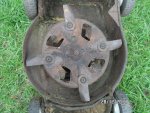
By the time the mower is set to about 3" the up draft is not strong enough to keep the clippings against the underside of the mower deck so they drop , get whacked by the flaps, recut and forced down into the grass.
Some say they sharpen the edge of the flaps and that recuts even finner but I have no idea about that .
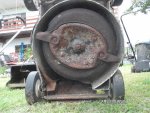
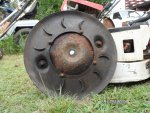
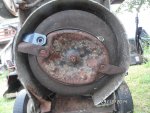
This is a Vortex Mk II blade plate, note there are no flaps in it and it is a slightly modified oval 2 blade plate with a rubber skirt
The the next photo is the top side of the skirt showing the little fan blades that on the original were part of the full round pressing similat to the one in the top image.
The next is a Mk I Vortex blade sitting loose on the Mk II Vortex blade plate just to give you an idea of how much bigger the MK I blade plate was as they both swung inside the same deck and had the same cut.
Below is a naughty one I could not resist popping in.
It came off a Mk II vortex that was damaged beyond repair because the idiot owner did not change his blades.
He brought it in for a new starter rope & when I asked about the blades I was told not to bother it was cutting fine.
After a brief inspection I told him I would not repair his mower as it was in a dangerious state. If he liked I would supply a new cord & show him how to replace it but my insurance would not allow me to send back a mower in that state.
After some abuse he finally saw good & I sold him a good 4 blade Victa and traded in the Vortex. Only the engine block, blade plate, snorkel & catcher were salvageable so I lost money on that one.
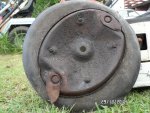
When the grass is cut and flung up by the flute on the blade it gets carried to the top against the base plate by virtue of its extra weight and thus momentum.
The flaps in the base plate redirect most of the air back down to the lawn then back up past the blades again.
Meanwhile the grass gets carried by the remaining air into the catcher.
The closer to the ground the mower is the stronger this action is.

By the time the mower is set to about 3" the up draft is not strong enough to keep the clippings against the underside of the mower deck so they drop , get whacked by the flaps, recut and forced down into the grass.
Some say they sharpen the edge of the flaps and that recuts even finner but I have no idea about that .



This is a Vortex Mk II blade plate, note there are no flaps in it and it is a slightly modified oval 2 blade plate with a rubber skirt
The the next photo is the top side of the skirt showing the little fan blades that on the original were part of the full round pressing similat to the one in the top image.
The next is a Mk I Vortex blade sitting loose on the Mk II Vortex blade plate just to give you an idea of how much bigger the MK I blade plate was as they both swung inside the same deck and had the same cut.
Below is a naughty one I could not resist popping in.
It came off a Mk II vortex that was damaged beyond repair because the idiot owner did not change his blades.
He brought it in for a new starter rope & when I asked about the blades I was told not to bother it was cutting fine.
After a brief inspection I told him I would not repair his mower as it was in a dangerious state. If he liked I would supply a new cord & show him how to replace it but my insurance would not allow me to send back a mower in that state.
After some abuse he finally saw good & I sold him a good 4 blade Victa and traded in the Vortex. Only the engine block, blade plate, snorkel & catcher were salvageable so I lost money on that one.

#31

Two-Stroke
Two-Stroke
Here's a video of a very futuristic looking mower that actually launched in 1983. :cool2:
It looks like something out of a sci-fi movie -- as if it doesn't require anybody to operate it and even knows when the grass needs to be cut.
Link
Yeah... and it's a two-stroke. :thumbsup:
It looks like something out of a sci-fi movie -- as if it doesn't require anybody to operate it and even knows when the grass needs to be cut.
Link
Yeah... and it's a two-stroke. :thumbsup:
#32

Two-Stroke
Two-Stroke
The first Victa mower was built in 1952 by Mervyn Victor Richardson who wanted to help his son who had a lawn mowing business. It's now called the "Peach Tin Prototype" since he used an old peach can as a makeshift fuel tank. :laughing:
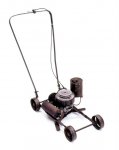
It was powered by a Villiers (a British small-engine manufacturer, founded in 1898) two-stroke engine that was probably intended for small motorbikes. I think it's 75cc -- but I'm not sure about that.
Here are some detail photos of the engine. If anybody can ID this engine, I'd appreciate it.
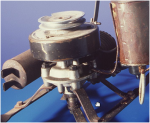
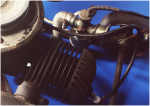
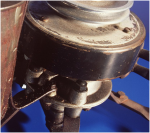
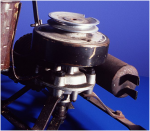
An interesting summary of the company's history can be found here.

It was powered by a Villiers (a British small-engine manufacturer, founded in 1898) two-stroke engine that was probably intended for small motorbikes. I think it's 75cc -- but I'm not sure about that.
Here are some detail photos of the engine. If anybody can ID this engine, I'd appreciate it.




An interesting summary of the company's history can be found here.
